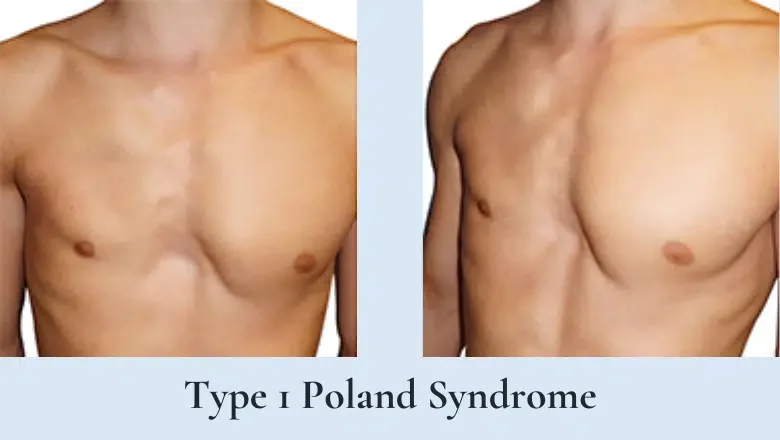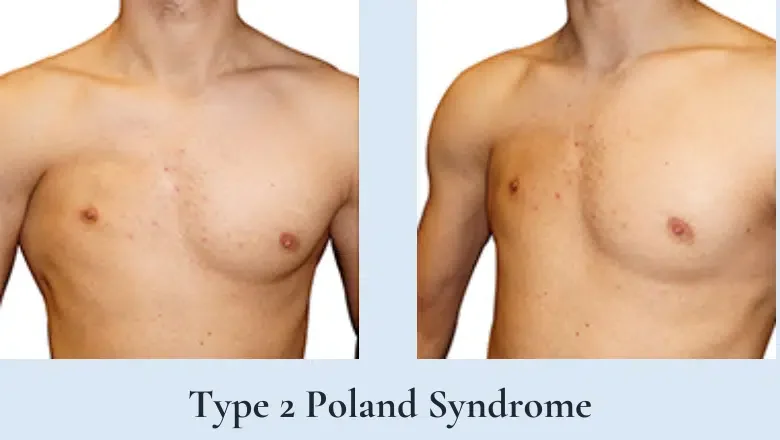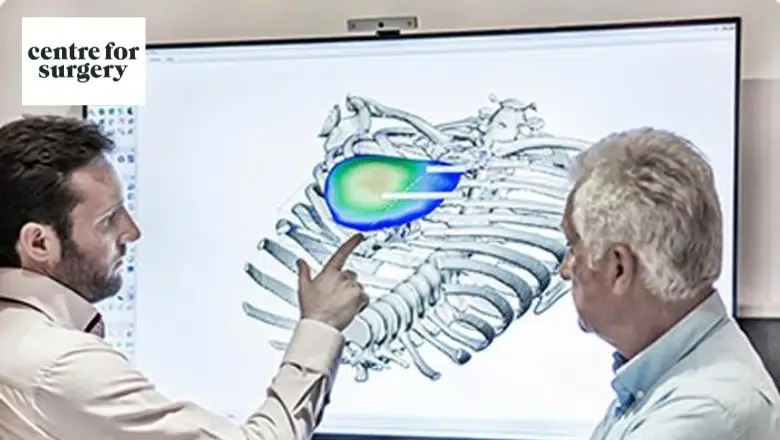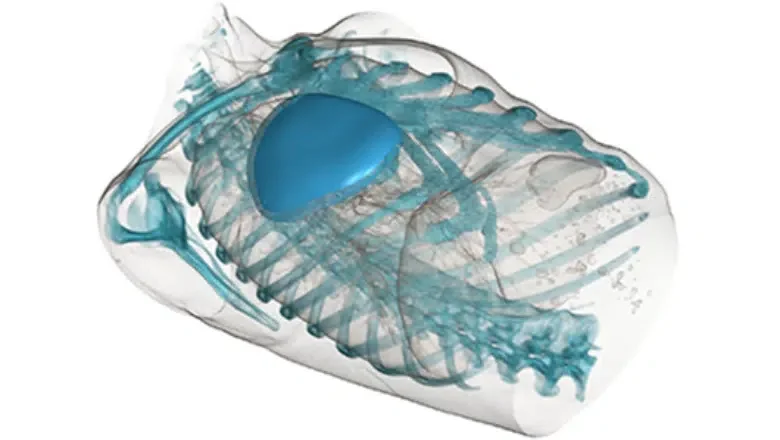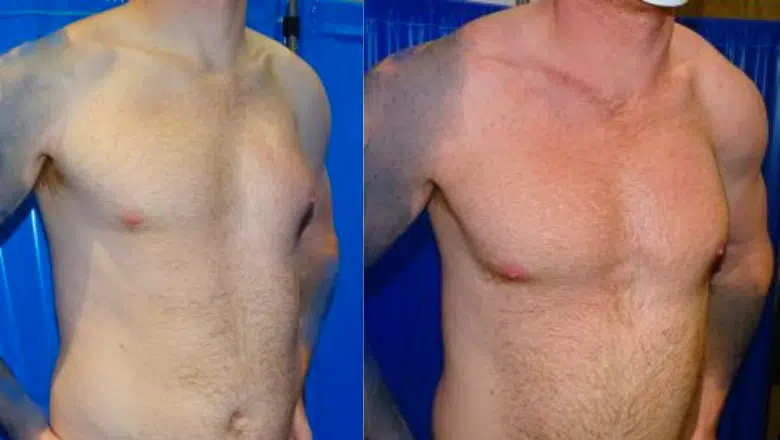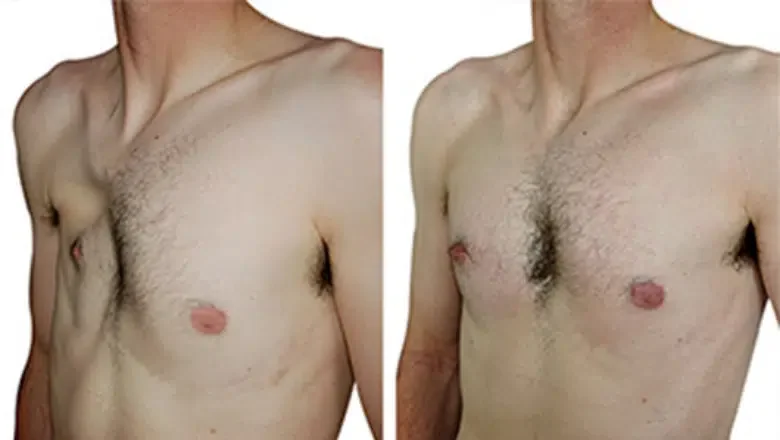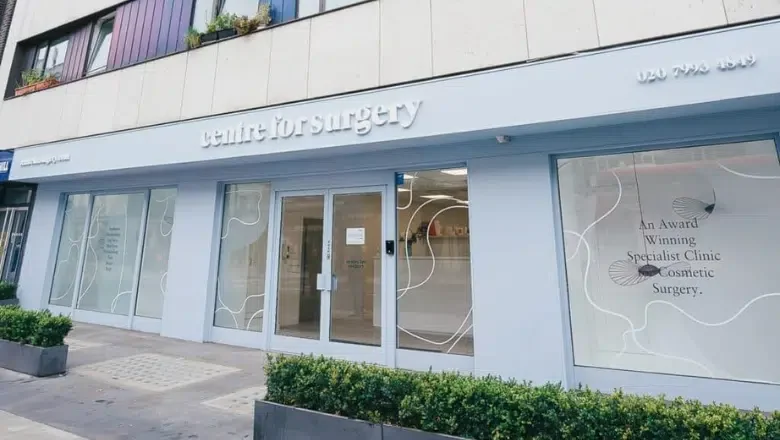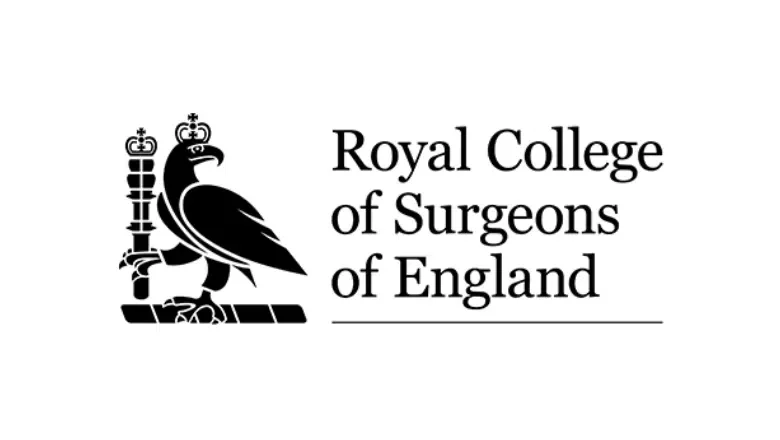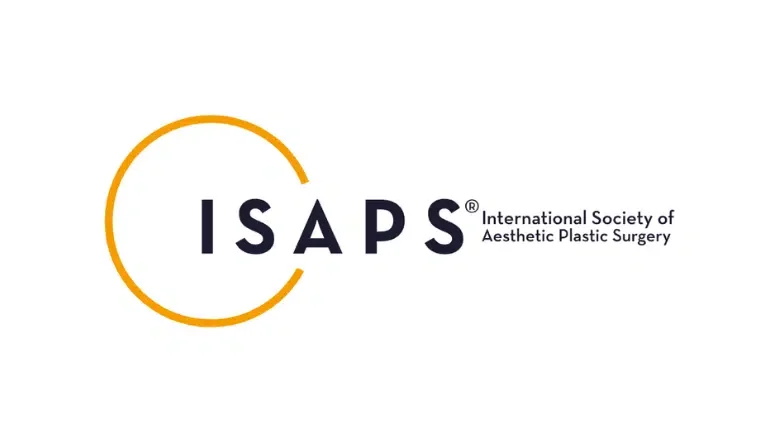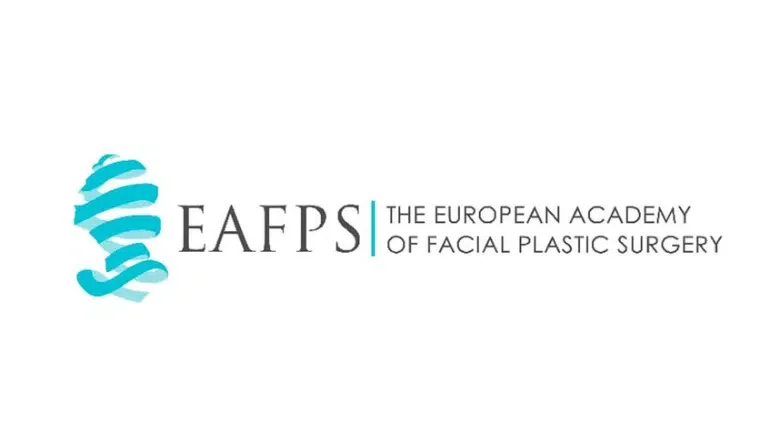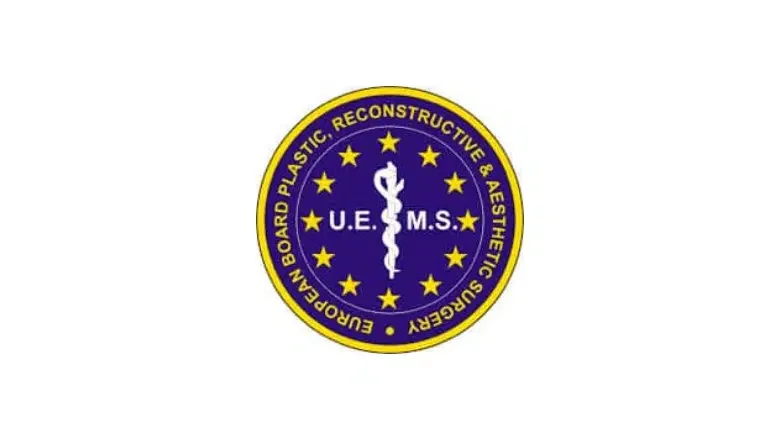Poland Syndrome 3D Custom Made Implants
Poland Syndrome is a rare congenital condition that affects the development of chest muscles on one side of the body. It can also lead to abnormalities in the ribs, breast tissue, and upper limb on the affected side. The severity of the condition varies from person to person, with some experiencing mild underdevelopment while others may have a significant absence of the pectoral muscles and breast tissue. This can lead to an imbalance in the chest’s appearance, which may cause both physical and emotional distress.
At Centre for Surgery, we specialise in advanced reconstructive techniques to address the aesthetic and functional concerns associated with Poland Syndrome. One of the most effective solutions for chest asymmetry caused by this condition is the use of 3D custom-designed implants, a cutting-edge approach that allows for precise correction tailored to each individual’s unique anatomy.
What is Poland Syndrome?
Poland Syndrome is a rare congenital condition that affects the development of the chest muscles, usually on one side of the body. It is present from birth and varies in severity, with some individuals experiencing only mild underdevelopment while others have a complete absence of certain muscles and tissues. The most common feature of Poland Syndrome is the partial or total absence of the pectoralis major muscle, which plays a key role in chest definition and upper body movement.
RELATED: What is Poland Syndrome?
This condition can also affect other structures, including the ribs, breast tissue, and, in some cases, the hand and arm on the same side of the body. When the upper limb is involved, it may appear smaller or have webbing between the fingers (a condition known as syndactyly). Poland Syndrome most commonly affects the right side of the body, although left-sided cases do occur. The exact severity and symptoms vary from person to person.
What Causes Poland Syndrome?
The exact cause of Poland Syndrome is not fully understood, but it is believed to result from an interruption in blood flow during early foetal development. Around the sixth week of pregnancy, the blood supply to the chest wall and upper limb may become restricted, preventing proper growth of the muscles and surrounding tissues. However, Poland Syndrome is not usually inherited, and in most cases, it occurs randomly.
While researchers continue to study the condition, there is no clear genetic link, meaning it does not typically run in families. However, some rare familial cases have been reported.
What Are the Symptoms of Poland Syndrome?
The symptoms of Poland Syndrome can vary widely, depending on the severity of the muscle and tissue underdevelopment. The most common features include:
- Underdeveloped or missing pectoral muscle: The chest on one side may appear flatter or asymmetrical.
- Absent or underdeveloped breast tissue: This is more noticeable in women, where one breast may be significantly smaller or entirely absent.
- Rib abnormalities: Some individuals may have missing or underdeveloped ribs, which can affect chest wall structure.
- Differences in the hand or arm: In some cases, the affected side may have a smaller hand, shorter fingers, or webbing between the fingers.
Most individuals with Poland Syndrome are otherwise healthy and do not experience major medical problems related to the condition. However, the cosmetic impact of chest asymmetry can be a concern, particularly during adolescence or adulthood.
Classification of Poland Syndrome
Poland Syndrome can be classified into three distinct types based on the degree of atrophy (underdevelopment) of soft tissues such as fat, skin, and breast tissue (in women) and the extent of bone abnormalities affecting the ribs and chest wall. The classification helps determine the severity of the condition and guides the choice of treatment.
Type 1: Mild Form
In the mildest cases, Poland Syndrome primarily affects the soft tissues, including the pectoral muscle, subcutaneous fat, and skin. There is usually no significant rib deformity or chest wall involvement.
- The pectoralis major muscle may be partially underdeveloped but still present.
- In women, there may be mild breast hypoplasia (smaller breast size), but the shape of the chest remains relatively normal.
- There is little to no involvement of the ribs or sternum.
- The hand and arm are typically unaffected.
Patients with this form of Poland Syndrome may have a subtle asymmetry that becomes more noticeable during puberty, particularly in women due to the impact on breast development. Treatment options typically involve fat transfer or implants to restore symmetry.
Type 2: Moderate Form
This type of Poland Syndrome is more severe, involving both soft tissue atrophy and partial rib deformity. The pectoralis major muscle is often completely absent, and there may be visible chest asymmetry.
- The affected side of the chest may appear sunken due to the absence of muscle and fat.
- In women, breast development is significantly reduced, often requiring reconstruction.
- Ribs may be underdeveloped or partially absent, leading to a depression in the chest wall.
- The shoulder on the affected side may appear narrower.
- Mild hand abnormalities, such as shortened fingers, may be present.
Surgical correction often involves custom-designed chest implants or autologous fat grafting to restore symmetry. Rib defects may require additional chest wall reconstruction to improve structural support.
Type 3: Severe Form
The most severe form of Poland Syndrome includes significant underdevelopment of both the chest wall and upper limb. This type affects soft tissues, bones, and the hand, leading to noticeable physical differences.
- The pectoralis major and minor muscles are completely absent.
- Multiple ribs are missing or severely underdeveloped, causing a concave chest wall (pectus excavatum-like appearance).
- The breast and surrounding soft tissues are either completely absent or extremely underdeveloped.
- The shoulder, arm, and hand on the affected side may be smaller.
- Syndactyly (webbing of fingers) or brachydactyly (shortened fingers) is often present.
This form of Poland Syndrome requires comprehensive reconstructive surgery, including rib grafting, chest implants, breast reconstruction, and possibly hand surgery to improve both function and appearance.
Poland Syndrome: 3D Custom-Made Implant Technique
Traditional implants often fail to provide a natural and symmetrical appearance due to the unique anatomical differences in each patient. The 3D custom-made implant technique is a cutting-edge solution that ensures a precise fit, restoring balance and improving the overall contour of the chest.
At Centre for Surgery, we utilise state-of-the-art 3D scanning and digital modelling technology to create fully customised implants tailored to each patient’s unique anatomy. Unlike standard implants, which may not perfectly match the unaffected side, 3D custom-made implants provide a precise anatomical fit, significantly enhancing the aesthetic outcome.
This technique is particularly effective for individuals with Poland Syndrome because it allows for the restoration of natural contours without the limitations of off-the-shelf implants. The process involves several high-precision steps, ensuring a seamless and natural-looking result.
Step-by-Step Process of 3D Custom Implant Design
Developing a customised silicone implant involves a highly detailed, multi-stage process, ensuring accuracy and durability.
3D Chest Scan
The process begins with a high-resolution 3D scan of the patient’s chest. This scan captures the exact shape, size, and contours of both the affected and unaffected sides, allowing surgeons to assess the degree of asymmetry.
The next step involves the segmentation of different tissue layers, including the skin, fascia, muscles, and bones. This enables the creation of a digital copy of the patient’s anatomy, which serves as the foundation for designing the implant.
Personalised Implant Design
Using advanced computer-aided design (CAD) software, a fully personalised implant is created to match the contours of the unaffected side. The digital implant is designed with precise thickness, shape, and volume to ensure natural symmetry and a smooth transition with the existing chest wall.
Creation of a Polyurethane Prototype and Mould
Once the implant design is finalised, a polyurethane prototype is produced. This prototype acts as a model to create the final mould, ensuring an exact fit before manufacturing the final implant.
Manufacturing the Silicone Implant
The custom mould is used to create the final medical-grade silicone implant, ensuring it is both durable and biocompatible. The implant is designed to be permanent, maintaining its shape and structure over time.
Professor Ertan Erel
Professor Ertan Erel is a highly respected plastic and reconstructive surgeon, specialising in Poland Syndrome correction. With extensive experience in custom-made 3D implants, he provides expert surgical solutions to restore chest symmetry and natural contours. His meticulous approach ensures each patient receives a bespoke treatment plan, tailored to their unique anatomy.
As a leading specialist, Professor Erel combines advanced surgical techniques with the latest medical technology, offering exceptional results with minimal scarring. His commitment to patient care and safety makes him a trusted name in Poland Syndrome treatment.
Patients under his care benefit from a comprehensive consultation, cutting-edge 3D imaging, and a highly personalised surgical experience. Based at Centre for Surgery in London, Professor Erel continues to transform lives by helping individuals regain confidence and body symmetry.
Benefits of Custom Silicone Implants
Custom implants offer several advantages over traditional implants, making them the preferred choice for Poland Syndrome reconstruction.
Superior Fit and Natural Appearance
Since each implant is individually designed, it provides a much better anatomical fit than standard implants, leading to a smoother and more symmetrical chest contour.
Long-Lasting and Safe Materials
AnatomikModeling custom implants are made from medical-grade polymerised silicone rubber supplied by NuSil, a globally recognised leader in high-performance biomaterials. The material is FDA-registered and meets strict international safety standards.
Puncture-Resistant and Tear-Proof Design
Unlike traditional silicone gel breast implants, which carry a risk of rupture or capsular contracture, these custom implants are made from solid silicone elastomer, eliminating concerns about leakage or shrinkage. The smooth surface also reduces the risk of complications.
Manufactured to the Highest Standards
The production of these implants adheres to strict ISO 9001 and ISO 13485 quality management systems, ensuring they comply with the European Medical Device Directive 93/42. This guarantees optimal safety, durability, and biocompatibility.
Poland Syndrome Surgery: Step-by-Step Procedure
Poland Syndrome surgery using a 3D custom-made implant is a highly advanced reconstructive procedure designed to restore chest symmetry by replacing the missing pectoralis major muscle. In women, the implant also helps to balance the breast, achieving a natural and proportional appearance.
At Centre for Surgery, we use a minimally invasive technique with an axillary incision, ensuring that the scar remains discreet and hidden in the natural fold of the armpit. The procedure is safe, effective, and performed as a day case under general anaesthesia, meaning patients can return home the same day.
Step-by-Step Surgical Process
General Anaesthesia and Preparation
The procedure is performed under general anaesthesia, ensuring that the patient remains comfortable and pain-free throughout. Once the patient is asleep, the surgical team carefully prepares the area for implantation.
Axillary Incision
A small incision of approximately 8cm is made in the natural fold of the armpit. This approach avoids visible scarring on the chest, keeping the results as natural as possible.
Creation of the Implant Pocket
The surgeon carefully prepares the subcutaneous pocket, shaping it to match the exact dimensions of the custom-made implant. This precise preparation ensures a perfect fit, allowing the implant to integrate seamlessly with the chest’s natural contours.
Implant Placement and Stabilisation
The custom silicone implant is gently inserted into the pocket, ensuring it sits securely in position. Unlike traditional implants, which may shift over time, this custom-designed implant is perfectly stabilised, preventing any downward movement or displacement.
Closure in Two Planes
Once the implant is correctly positioned, the surgeon closes the incision in two layers using absorbable sutures. This technique promotes strong wound healing and minimises the risk of complications.
Application of Compression Dressing
A circular compression bandage is applied around the chest to support the implant, reduce swelling, and help the body adjust to the new contours.
Recovery and Same-Day Discharge
The procedure takes approximately one hour, and since it is performed as a day case surgery, patients can return home the same day. Post-operative care instructions are provided to ensure a smooth recovery.
Surgical Outcomes and Recovery After Poland Syndrome Surgery
The results of Poland Syndrome correction using 3D custom-made implants are highly successful, providing a natural and symmetrical chest contour while ensuring a smooth and rapid recovery. Thanks to the minimally invasive technique used at Centre for Surgery, patients experience minimal discomfort, quick healing, and excellent long-term results.
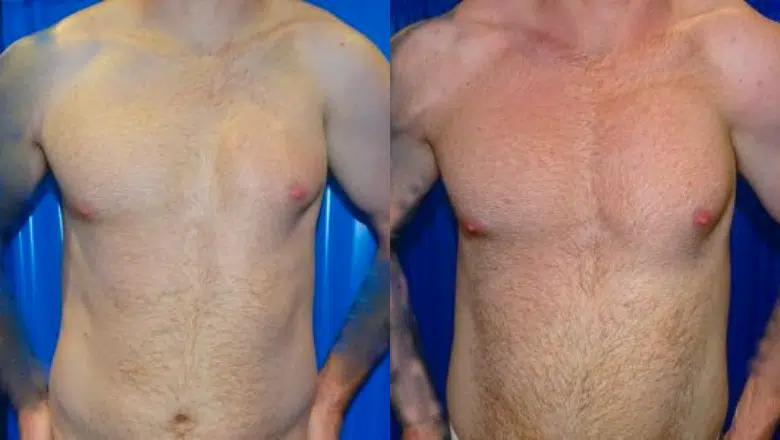

Recovery after surgery is straightforward, with little post-operative pain. Most patients find that simple pain relief, such as paracetamol or ibuprofen, is sufficient to manage any discomfort. There is no need for intensive post-operative care, as the stitches are absorbable, meaning they dissolve naturally without requiring removal. No surgical drains are needed, reducing inconvenience during the healing process. A protective dressing is applied for seven days, and patients are advised to wear a compression bra or vest for 14 days to support the implant and reduce swelling.
In some cases, a small seroma (fluid collection) may develop near the surgical site. If this occurs, it can be easily treated during a follow-up consultation within seven days, where the fluid is drained in a simple, painless procedure. This ensures that healing continues smoothly without complications.
Patients are advised to take 14 days off work to allow their body to recover. Those with desk-based jobs may find they can return sooner, depending on how they feel. Physical activities, particularly any involving the upper body, should be avoided for three months to allow the implant to fully stabilise. After this period, sports and fitness routines can be gradually resumed without restrictions.
The long-term results of Poland Syndrome surgery using 3D custom-designed implants are excellent. These implants are durable, stable, and designed to last a lifetime without the risk of movement or deformation. The high-quality medical-grade silicone used ensures long-term safety and biocompatibility, eliminating concerns about rupture or rejection.
Custom-Made Poland Syndrome Implants at Centre for Surgery
At Centre for Surgery, we specialise in custom-made 3D implants for Poland Syndrome correction, providing highly personalised solutions to restore chest symmetry and improve confidence. Our expert surgeons use cutting-edge technology to design bespoke silicone implants, ensuring a precise fit for each patient’s unique anatomy. With a commitment to exceptional surgical care, we focus on achieving the most natural-looking results while ensuring patient safety and satisfaction.
With years of experience in reconstructive and aesthetic surgery, we have helped countless individuals affected by Poland Syndrome regain confidence through advanced surgical techniques. Each procedure is tailored to the patient’s specific needs, ensuring that the chest contours appear balanced, symmetrical, and natural. Our state-of-the-art Baker Street clinic provides a comfortable, discreet, and professional environment where patients receive the highest level of care.
Why Choose Centre for Surgery for Poland Syndrome Treatment?
At Centre for Surgery, we understand that Poland Syndrome can have a significant impact on self-esteem and body image. Our team of highly skilled plastic surgeons has extensive expertise in custom implant reconstruction, ensuring a personalised treatment plan that delivers outstanding results. From the initial consultation to the final post-operative check-up, we provide comprehensive support to guide patients through every step of their journey.
We are dedicated to innovation in reconstructive surgery, utilising the latest 3D imaging technology to create implants that perfectly match the patient’s chest anatomy. Our meticulous approach to planning and execution guarantees a seamless integration of the implant, offering a natural, long-lasting result.
Real Patient Testimonials – Transforming Lives with Custom Poland Syndrome Implants
James, 29, London:
“I had always felt self-conscious about the asymmetry in my chest due to Poland Syndrome. After my consultation at Centre for Surgery, I felt reassured that I was in expert hands. The 3D custom implant technique was truly life-changing. The results are incredibly natural, and I finally feel confident in my own skin.”
Sarah, 35, Manchester:
“As a woman, Poland Syndrome affected not just my chest but also my confidence. The team at Centre for Surgery understood my concerns and provided a personalised approach to my treatment. The implant has restored my chest shape beautifully, and I couldn’t be happier with the results. The care I received throughout the process was outstanding.”
Michael, 41, Birmingham:
“The professionalism and expertise at Centre for Surgery are second to none. My custom implant was designed specifically for me, and the difference it has made in my life is remarkable. From the consultation to post-surgery care, the entire experience was smooth and stress-free. I highly recommend their services to anyone considering Poland Syndrome correction surgery.”
Book Your Consultation Today
If you are considering custom-made implants for Poland Syndrome, our expert team is here to help. We offer consultations at our Baker Street clinic, where our surgeons will assess your condition and provide a personalised treatment plan.
To book your consultation, contact us via:
📞 Phone: 0207 993 4849
📧 Email: contact@centreforsurgery.com
📍 Address: 95-97 Baker Street, London W1U 6RN
Learn More About Us
For more information about our clinic, our expert surgeons, and the advanced surgical techniques we offer, visit the following links:
🔗 About Us: Centre for Surgery – Why Choose Us
🔗 Meet Our Team: Our Expert Surgeons
🔗 Finance Options: Flexible Payment Plans, Including 0% APR
🔗 Plastic Surgery Blog: Latest Insights & Patient Stories
🔗 Clinic FAQs: Frequently Asked Questions
🔗 Baker Street Clinic: Our London Clinic Location
At Centre for Surgery, we are dedicated to providing the highest level of care in Poland Syndrome treatment. Whether you are exploring your options or ready to take the next step, we are here to support you on your journey to a more balanced and confident appearance.
FAQs
-
What steps should I take to prepare for surgery? Are there any preliminary screenings?The first step is to schedule a consultation with a specialist surgeon who will assess your condition and discuss your treatment options. During this consultation, a 3D scan of your chest will be performed to create a detailed digital model of your thorax. Additionally, photographs will be taken from the front and at slight angles from both sides. These images help in designing a custom implant that fits perfectly with your unique anatomy.
-
Can custom-made implants be combined with breast implants?Yes, it is possible to have both procedures, but they cannot be done at the same time. The surgeries must be performed at least six months apart, beginning with the custom thoracic implant. In some cases, particularly when breast asymmetry is caused by Pectus Excavatum, the chest implant alone can naturally enhance breast shape and size. This means that some patients may find that a breast implant is no longer necessary after the first procedure.
-
At what age can someone undergo surgery with a custom-made implant?Surgery for chest correction is recommended from the age of 18 and onwards, once puberty has finished and the chest structure has stabilised. Since the thoracic area is no longer changing, this ensures the best possible results. Individuals in good overall health can undergo this procedure up to the age of 65, provided they meet the necessary medical criteria for surgery.
-
Is the surgery painful?Patients generally experience mild discomfort rather than intense pain following surgery. The procedure itself is performed under general anaesthesia, so there is no sensation during the operation. After surgery, most patients find that simple painkillers, such as paracetamol or ibuprofen, are enough to manage any temporary discomfort. The recovery process is designed to be as smooth as possible, with minimal downtime and a quick return to daily activities.


